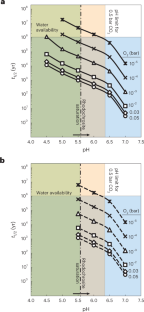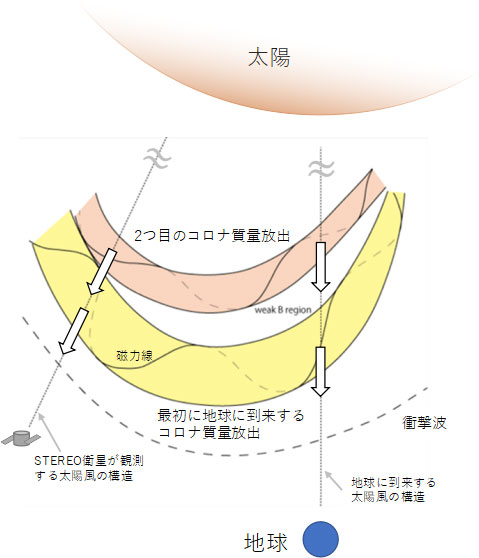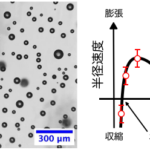2014年にNASAの火星探査機が火星のゲールクレーターとエンデバークレーターの岩石からマンガン酸化物を発見したとき、この発見をきっかけに、赤い惑星の大気には数十億年前にかつてもっと酸素があったかもしれないと考える科学者が現れました。 When NASA’s Mars rovers found manganese oxides in rocks in the Gale and Endeavor craters on Mars in 2014, the discovery sparked some scientists to suggest that the red planet might have once had more oxygen in its atmosphere billions of years ago.
2022-12-22 ワシントン大学セントルイス
しかし、ワシントン大学(セントルイス)の新しい実験的研究は、この見解を覆すものである。火星に似た条件下では、大気中の酸素がなくてもマンガン酸化物が容易に生成されることを発見しました。また、動態モデリングを用いて、古代の火星で予想される二酸化炭素の多い大気中では、マンガンの酸化は不可能であることも明らかにしました。
火星は地球に比べてハロゲン元素である塩素と臭素が豊富に存在する惑星である。「ハロゲンは火星では地球上とは異なる形で、しかもはるかに大量に発生するので、マンガンの運命に重要な役割を果たすと推測されました」とカタラーノは語った。
カタラーノとミトラは、火星で主流の塩素酸塩と臭素酸塩を使って、太古の火星表面の流体を再現した水サンプル中のマンガンを酸化させる実験を行っています。
科学者達は、ハロゲンが、水に溶けているマンガンを、酸素によってよりも数千から数百万倍速く、酸化マンガン鉱物に変換することを発見しました。さらに、初期の火星の表面にあったと科学者が考えている弱酸性の条件下では、臭素酸塩は他のどの酸化剤よりも速くマンガン酸化鉱物を生成する。これらの条件の多くでは、酸素はマンガン酸化物を形成することが全くできないのです。
しかし、過去に大気中の酸素が無かった可能性が高いからと言って、生命が存在しなかったと信じる特別な理由はないと、科学者達は言っています。
「地球上でさえ、生存に酸素を必要としない生命体がいくつかあります」と、ミトラは言った。”私は、居住可能性の「後退」とは考えていません。”ただ、酸素を利用する生命体がいなかったのだろうということです。
ハロゲンが豊富な環境で生存できる極限環境生物-地球のグレートソルトレイクや死海で繁栄する塩を好む単細胞生物やバクテリアのように-も火星でうまくいくかもしれません。
<関連情報>
- https://source.wustl.edu/2022/12/experimentalists-sorry-no-oxygen-required-to-make-these-minerals-on-mars/
- https://www.nature.com/articles/s41561-022-01094-y
初期火星におけるハロゲンサイクルに伴うマンガン酸化物の形成 Formation of manganese oxides on early Mars due to active halogen cycling
Kaushik Mitra,Eleanor L. Moreland,Greg J. Ledingham & Jeffrey G. Catalano
Nature Geoscience Published:22 December 2022
DOI:https://doi.org/10.1038/s41561-022-01094-y

Abstract
In situ rover investigations on Mars have discovered manganese oxides as fracture-filling materials at Gale and Endeavour craters. Previous studies interpreted these minerals as indicators of atmospheric oxygen on early Mars. By contrast, we propose that the oxidation of manganese by oxygen is highly unlikely because of exceedingly slow reaction kinetics under Mars-like conditions and therefore requires more reactive oxidants. Here we conduct kinetic experiments to determine the reactivity of the oxyhalogen species chlorate and bromate for oxidizing dissolved Mn(II) in Mars-like fluids. We find that oxyhalogen species, which are widespread on the surface of Mars, induce substantially greater manganese oxidation rates than O2. From comparisons of the potential oxidation rates of all available oxidants (including reactive oxygen species peroxide and superoxide), we suggest that the oxyhalogen species are the most plausible manganese oxidants on Mars. In addition, our experiments precipitated the manganese oxide mineral nsutite, which is spectrally similar to the dark manganese accumulations reported on Mars. Our results provide a feasible pathway to form manganese oxides under expected geochemical conditions on early Mars and suggest that these phases may record an active halogen cycle rather than substantial atmospheric oxygenation.



